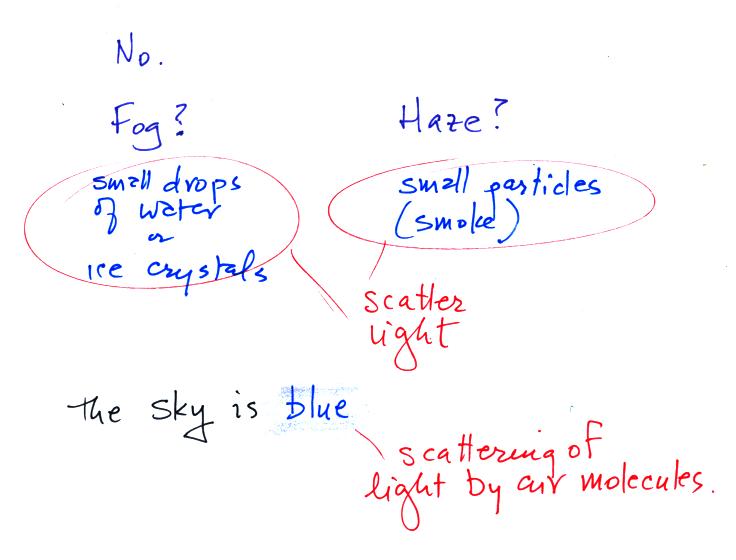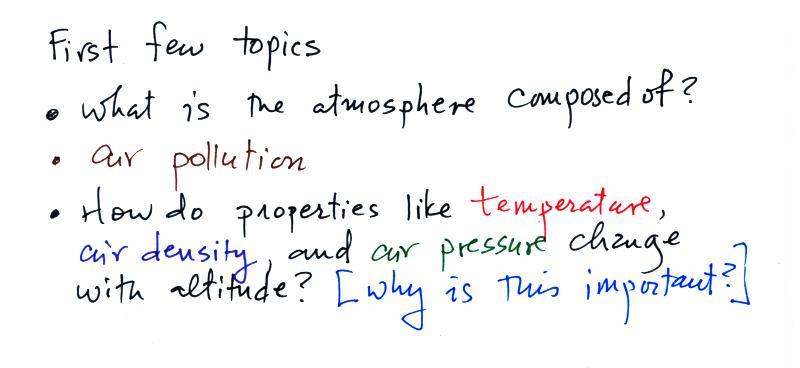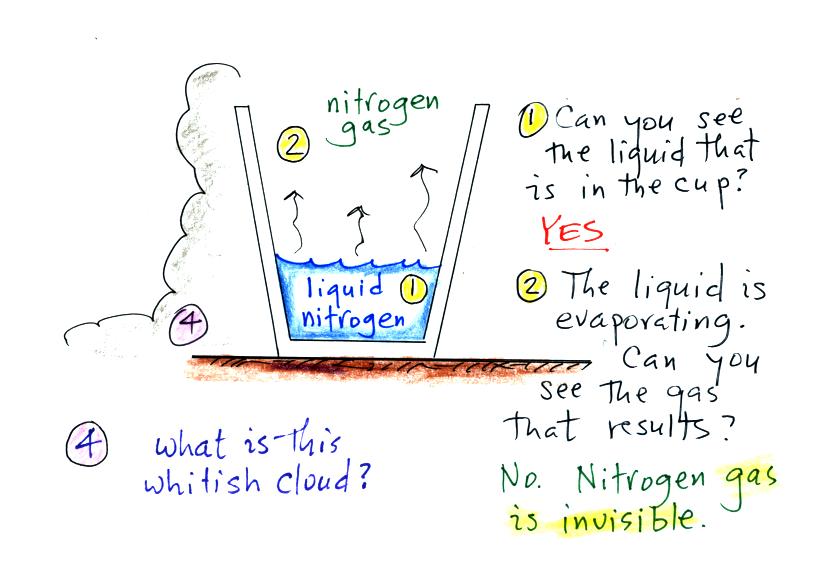
This is a little more detailed
answer to this question than was given in class. Air is
normally clear, transparent, and invisible (that would be true of the
air in the
classroom). Sometimes the air looks
foggy or hazy. In these two cases you are seeing the effects of
small water droplets or ice crystals (fog) or small particles of dust
or smoke (haze). The particles themselves may be too small
to be seen with
the naked eye but are visible because they scatter (redirect)
light. Scattering is a pretty important concept and we will learn
more about it in a week
or two.
The atmosphere isn't actually clear. When sunlight shines
through the atmosphere the sky appears blue. I didn't mention
this in class. This is a little more
complicated form of scattering of sunlight by air molecules.
Can
you
feel
air

It
is harder to answer this question. We're always in contact with
air. Maybe we've grown so accustomed to it we aren't aware of how
it feels. We can certainly feel whether
the air is hot or cold, but that have more to do with energy exchange
between us and our surroundings. We will see that air pressure is
pressing on
every square
inch of our bodies with 12 or 13 pounds of force. If that were to
change suddenly I'm pretty sure we'd feel it and it would probably
really hurt.
What
are
the
5
most
abundant
gases in air?
Let's start with the most abundant gas in the
atmosphere.
I poured some of this same material (in liquid form) into a styrofoam
cup. Here's a photo
You can see the liquid, it's clear, it looks like water.
Note
the
cloud
surrounding
the cup. At least one
student (probably many more) knew that this was nitrogen. We'll
use
liquid
nitrogen
in
several class
demonstration this semester.
The liquid nitrogen is evaporating. Can you see the nitrogen
gas? The answer is no, nitrogen
gas is invisible as are
most of the
other gases in the atmosphere. The whitish cloud is something
else, it's not nitrogen gas.
Nitrogen was
discovered in 1772 by Daniel Rutherford (a Scottish
botanist). Atmospheric nitrogen is relatively unreactive
and is sometimes used to replace air in packaged foods to preserve
freshness.
Oxygen
is
the second most abundant gas in the atmosphere. Oxygen is the
most abundant element (by mass) in the earth's crust, in ocean water,
and in the human body. Here's
a
photograph of liquid oxygen.
It has a (very faint) blue
color (I was pretty disappointed when I saw the picture the first
time because I had imagined the liquid oxygen might be a deep vivid
blue).
When heated (such as in an automobile engine) the oxygen and
nitrogen in air react
to form compounds such as nitric oxide (NO), nitrogen dioxide (NO2),
and
nitrous
oxide
(N2O). Together as a group these are
called oxides of nitrogen; the first two are air
pollutants, the
last is a greenhouse gas. More about those in class in the next
day or two.
Here are the 5 most abundant gases
in the earth's atmosphere.

Water vapor and argon are the 3rd
and 4th most abundant
gases in the
atmosphere. The concentration of water vapor can vary from near
0% to as high as 3% or 4%. Water vapor is, in many locations, the
3rd
most abundant gas in air. In Tucson most of the year, the air is
dry enough
that argon is in 3rd position and water vapor is 4th.
Water vapor, a gas, is
invisible. Clouds are visible because they are made up of small
drops of liquid
water or ice crystals. We can see clouds even though the
individual water droplets are too small to be seen because they scatter
light. Water is the only compound that exists
naturally in solid, liquid, and gaseous phases in the atmosphere.
Argon is an unreactive noble gas (helium, neon, krypton, xenon, and radon are also inert gases).
Noble gases are often used in "neon
signs."
Here's a little more
explanation (from Wikipedia)
of
why
noble
gases
are
so unreactive. Don't worry about all these
additional details. The noble gases have full valence electron shells. Valence electrons
are the outermost electrons of an atom and are normally
the only electrons that participate in chemical bonding.
Atoms with full valence electron shells are extremely stable and
therefore do not tend to form chemical bonds and have little tendency
to gain or lose electrons.
We didn't have time
to cover most of the rest of this material in class on Monday.
We'll review it quickly at the start of class on Wednesday.
Water
plays an important role in the formation of
clouds,
storms,
and weather. Meteorologists are very interested in knowing and
keeping track of how
much water vapor is in the air at a particular place and time.
One of the variables they use is the dew point temperature. The
value
of
the
dew
point
gives
you
an
idea
of
how
much
water
vapor
is
actually in the air. The
higher the dew
point value, the more water vapor the higher the water vapor
concentration.

The chart below gives a rough
equivalence between dew point
temperature and percentage concentration of water vapor in the air.
Air temperature will
always be equal to or warmer than
the dew point
temperature. Experiencing 80o dew points would be very
unpleasant (and possibly life threatening because your body might not
be able to cool itself). Click
here
to see current dew point temperatures across the U.S. And here's an
interesting link I just found concerning unusually high, even
record setting dew point temperatures.
Don't worry
about remembering all these numbers. Just remember that the
higher the dew point temperature the more water vapor is in the air and
vice versa.
The second job of the dew point temperature is
We can go back to the cup of liquid nitrogen and see this
happening. We'll concentrate on points 3 and 4 in the class
handout.

The cloud came from moisture in the
air. It's not different from the clouds you see forming in the
atmosphere outdoors. The cloud was not made of nitrogen gas
(which is
invisible). Note also that a certain amount of "artistic" license
was used in the figure above (and in many of my figures); liquid
nitrogen is not purple and water
clouds are not green.
Here's a summary of what we've seen happen in class today.













